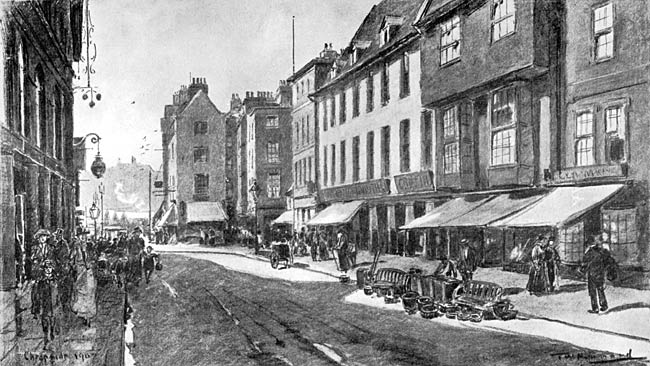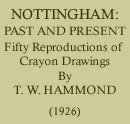< Previous | Contents | Next >
NOTTINGHAM PAST & PRESENT: STREETS AND YARDS
CHEAPSIDE, 1907

Until 1801, close to the point from which this picture is drawn, stood a cross which was called the 'Hen Cross', around whose foot on market days were exposed for sale all sorts of country produce, such as butter, eggs, and poultry; this market being much frequented by housewives was nicknamed the 'Womens Market'.
On the left side of the picture is a row of shops, known as 'Cheapside', which was called 'Rotten Row' from 1666 to 1810. Cheapside, of course, simply means 'the side of the market', for the old name for market was 'Chepe', a name which has come down to us in the many 'Chippings', such as 'Chipping Camdon', which are scattered about the modern map of England.
The other side of the picture shows us a row of houses now called the 'Poultry', but better known in olden times as 'Cuckstool Row' because the Cucking-stool was kept there. This dire implement of torture was used for correcting scolds. To its seat were firmly strapped the good ladies who were unable to control their tongues, and they were ducked until they became unconscious. It is not known where this rite was actually carried out, but there was a horse pond somewhere in the Market Place, and it seems probable that it would be the site of the ceremony.
Modern necessities have destroyed some of the beauties of the Poultry, but this picture fortunately retains them for us. The house, at the extreme right of the picture, with the bow windows (which were the last ancient bow windows in Nottingham) is the traditional house of the Earl of Mansfield, who was so much associated with the accession of William and Mary, and it was refronted after the Restoration. The adjoining building was the tenement of William Babbington, Esq., whose family name brings up tragic memories of the romantic acts of Anthony Babbington in his efforts to save Mary Queen of Scots.
Opposite the lamp post shown on this side of the picture is a low two storied building in which Henry Kirk White the poet was born on the 25th March, 1725, and close to this lamp post is the one remaining example of the ancient posts which carried the projecting upper stories for which Nottingham Market Place is famous.
